Beyond The Ruins: Uncovering Things To Do At Machu Picchu
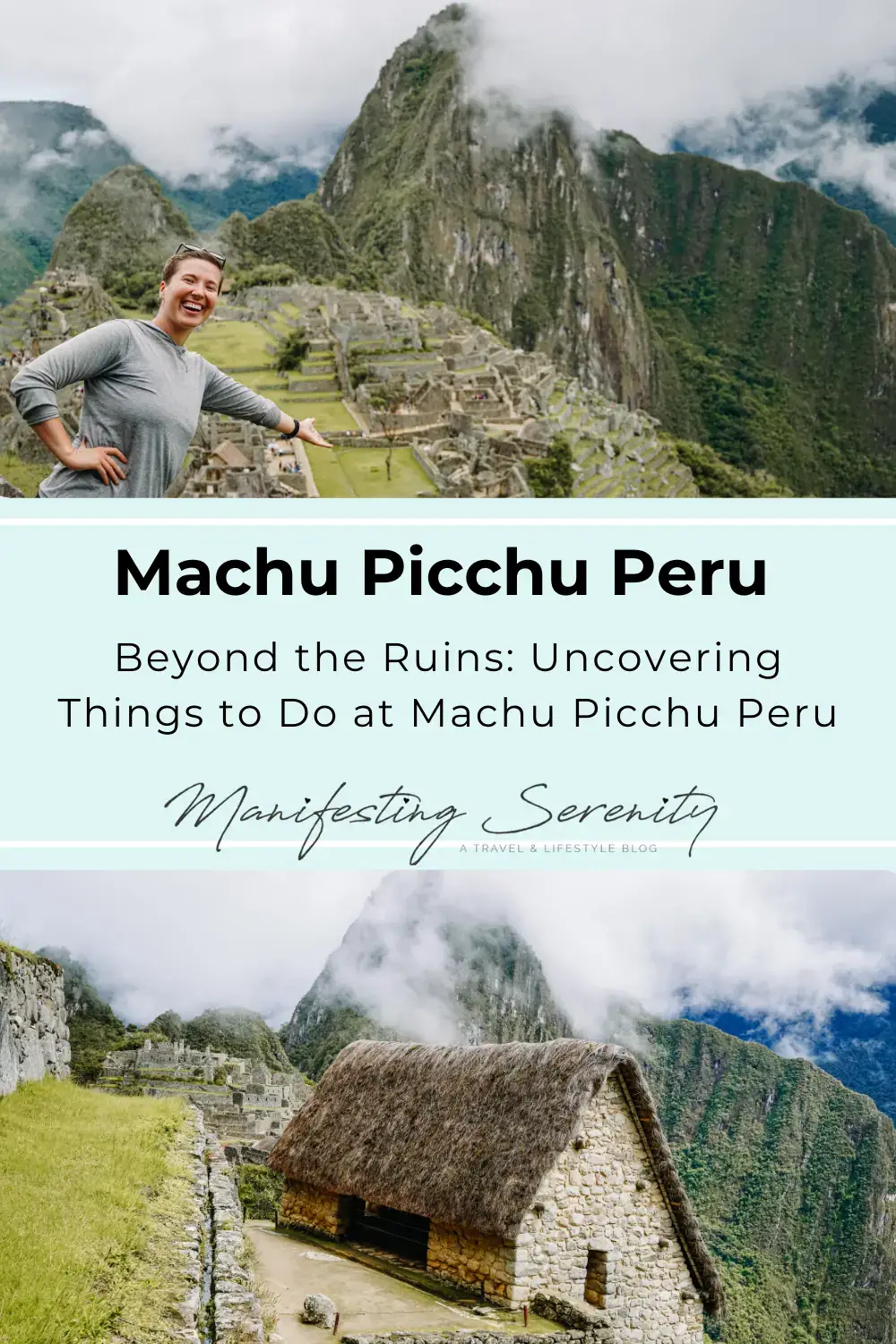
Looking for things to do at Machu Picchu? You’ve come to the right place, this wonder of the world can not be missed! We’ve dedicated this entire article to helping you experience it.
Located high in the Andean hills, Machu Picchu is a majestic and mysterious city, considered to be one of the world’s most dreamed-about destinations. It’s the 15th century Inca Empire state of origin, and tourists from all over the world still can’t afford to think that people once lived in such a majestic place.
Being Peru’s most superior tourist attraction, the mysterious “Lost City of the Incas” allows us to enjoy a journey in time to be amazed by its out of this world heritage, breathtaking views, sacred valley, and mesmerizing heritage.
Some links in this post may be affiliate links or this article may contain sponsored content, which means if you make a purchase, we receive a small compensation at no added cost to you. As an Amazon Associate I earn from qualifying purchases. Any purchases you make helps to keep this blog going and keeps our content free. I truly appreciate your support! Visit my Privacy Policy & Disclosure Policy for more info!
PeruTravel Resources Key
All resources on our site are shared to fuel and inspire you to be able to confidently, courageously, and sustainably explore this beautiful world.
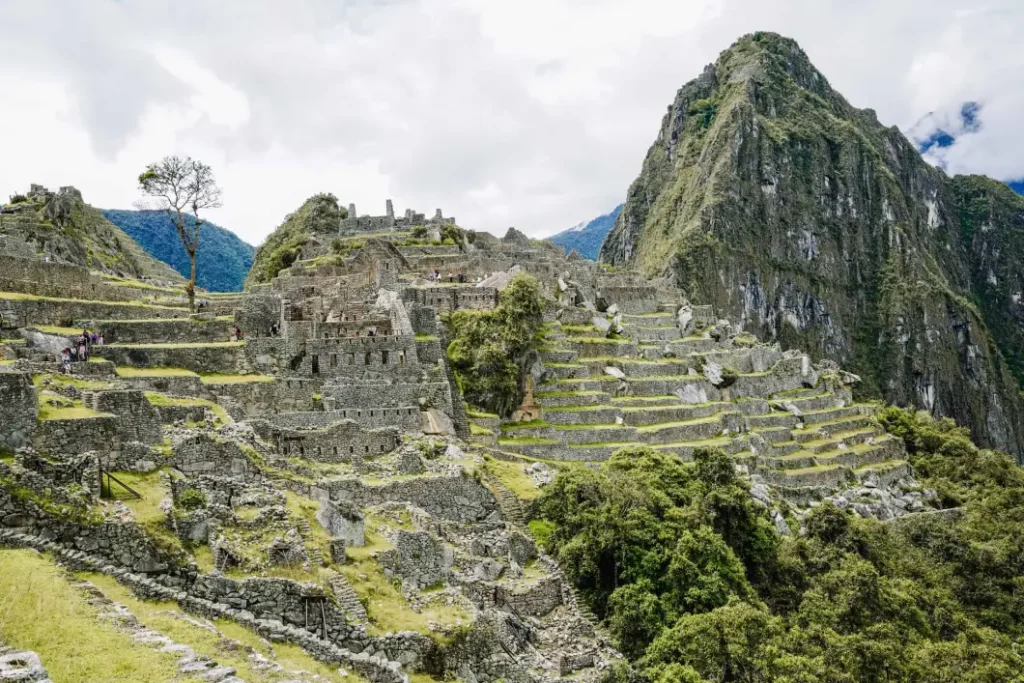
Entrance Fees & Permits
Machu Picchu admission fees vary depending on the kind of ticket you desire, the website you buy it, or the agency you go through. If you’d like to go without an agency and lead the trip on your own, tickets may be purchased at the normal price of “Peruvian soles” on the official website of the Peruvian Ministry of Culture. For Machu Picchu, there are five distinct sorts of permits, and each one offers a unique experience.
1. Machu Picchu permit only
This ticket allows you to visit the entire citadel of Machu Picchu.
- Adult: $48 (152 soles)
- Students: $25 (77 soles)
- Kids (8 to 17 years old): $19 (60 soles)
- Machu Picchu Permit and Huayna Picchu
Together with climbing Huayna Picchu mountain, it lets you explore the Inca city of Machu Picchu. This ticket needs to be purchased four months ahead of time. For those who have a phobia of heights, this permission is not advised.
- Adult: $63 (200 soles)
- Students: $39 (125 soles)
- Kids (8 to 17 years old): $37 (118 soles)
- Machu Picchu permit and Machu Picchu Mountain
With this permit, you may climb Machu Picchu mountain and have a tour of Inca city. It has to be purchased a few weeks in advance. Adventurers are advised to get the permissions.
- Adult: $63(200 soles)
- Students: $39 (125 soles)
- Kids (8 to 17 years old): $37 (118 soles)
4. Machu Picchu permit and Inca Bridge
With this ticket, you may visit Machu Picchu by circuits 1 or 2, enter the upper area, and then trek to the Inca bridge.
- Adult: $48 (152 soles)
- Students: $25 (77 soles)
- Kids (8 to 17 years old): $19 (60 soles)
Inca Trail Permits
Travelers can take a bus or rail, or hike via unofficial paths, to reach Machu Picchu. There are several limits that should be considered if you’re planning to hike the entire Inca Trail. It’s likely that you are already aware of how popular Machu Picchu is and how limited the number of tickets is. To fully enjoy the once-in-a-lifetime thrill of trekking the Inca Trail, you will require a permit. Since 2001, the Peruvian government has mandated this requirement.
Lastly, just a reminder that you will need to have your passport with you the entire walk and be prepared to provide it upon request from a government official. Though it’s sometimes commonly referred to as the Inca Trail entrance charge, the admission price is really for accessing the Machu Picchu Historic Sanctuary, which is home to the Inca Trail.
Ways To Get Tickets For Machu Picchu
A Machu Picchu ticket may be purchased in three different ways: in person at an authorized office in Cusco, online from any nation via the official ticket website, or through an approved travel agency.
- Secure your ticket on the internet.
Go to www.machupicchu.gob.pe, the Ministry of Culture’s official website, and select English by clicking the UK flag in the upper right corner of the page. Please note that the website is not constantly operational and that purchasing your Machu Picchu permit online may occasionally be difficult.
- As soon as you get to Cusco, purchase your tickets.
Option 1: Present your passport to the “Direccion Regional de Cultura” office at Street Garcilaso s/n Cusco. The Garcilaso House is located just two streets from the Plaza de Armas, the city’s main center.
Option 2: Proceed to Maruri Street 324. Cusco City’s Main Square is a short distance away.
Opening times are 07:00–19:00, Monday through Saturday. Sundays and holidays are closed. This is a riskier alternative, particularly during the busiest time of year when permits sell out quickly.
- Use a tour operator to buy your ticket.
Purchasing a Machu Picchu permit from an accredited travel agency, which will get your admission ticket, is the simplest, safest, and most effective option. All you have to give is a copy of your passport along with the visitation date.
Here are some ticketing companies and the options that they offer: Viator is a general experience booking site, through trusted vendors. As well as Book Retreats, and through Pacha Munay Wellness (This was the retreat center that I’d stayed at and went through for the tour.)
Machu Picchu By Bus
If you’re looking for the cheapest way to get to Machu Picchu, riding a bus would be the best answer. Bus tickets cost around $70 (263.66 soles), round trip, per person. However, if you’re the type of person who hates traveling for long durations, this might not be a good idea for you.
There are just two bus routes planned each day, and they typically depart between 14:00 and 16:00 pm. Buses leave as early as five in the morning to drive up the winding route that winds through the mountains to the Machu Picchu entrance gates. Cruz del Sur, Civa, Tepsa, and Movil Tours are considered to be the most reliable bus companies, so make sure to take good notes of them!
Bus from Sacred Valley to Machu Picchu:
The Ollantaytambo station, which is ideally only 25 minutes away. By bus, Machu Picchu is about thirty-one miles (52 kilometers) from the Sacred Valley. This trip will cost around $4 (15.06 soles).
Bus from Cusco to Machu Picchu: Taking a ground transportation (private automobile, van, minivan, or public bus) from Cusco to Santa Teresa, which is 204 kilometers northwest of Cusco and takes about five hours. This is the newest method of transportation to Machu Picchu, and an approximate round-trip cost is $80 (301.31 soles).
Also, every bus company has its own station where the buses leave and arrive. One of the travel rewards you’ll get when riding a bus is the greater chances of seeing beautiful landscapes during the early morning because, as it gets later, it’ll also get darker, making it difficult to see the beauty.
Machu Picchu By Airline
Although flying into Peru’s capital city, Lima, is absolutely the most common route to Machu Picchu, it is a longer one. After your flight to Lima, you’ll be transferred to an interal 1h 15m flight to Cuzco. Cuzco’s located on the Andes base, the southeast of Peru. It’s considered to be the capital of the Inca people and is currently the leaping off-point for Machu Picchu and the Sacred Valley.
So, if you’d like something is a bit more direct, flying into Cusco, would be much easier, faster and simpler. Machu Picchu is closes to the Cusco Airport, so it would be best to fly here and then take whichever mode of transportation you may need from the airport.
It may be best to choose the city that either better suits your budget, or whichever one you’d like to explore for a couple of days.
🌿 Wellness Tip: It’s also important to note, it’s best to allow yourself to adjust and acclimate to the elevation before hiking Machu Picchu. If you rush it, elevation sickness will make it difficult to do anything. So, be sure to take a couple of days at least to rest, drink local cocoa leaf tea, get oxygen cans, practice breaths, and walk around town to adjust to the differences.
Machu Picchu By Rail Train
One good reason to take yourself on a scenic train ride is to better immerse yourself in the greenish, natural charm of the city, Urubamba River, and mountain silhouettes. The train’s route will take you to sites that are extremely fascinating and relaxing to look at, and one of them is the Sacred Valley. From basic carriages in the Vistadome services or IncaRail with mesmerizing windows, to the luxurious Hiram Bingham Train with fine dining, there’s surely comprehensive rail services designed for your comfort and satisfaction
The duration of train rides vary based on the departure point you chose. There are a wide range of options to choose from, ranging from a few hours to a day trip or full-day travel, so feel free to pick the time that best matches your schedule. To secure your choice of departure time and type of service, I suggest you book train tickets as early as possible. Whichever route you choose, I’m confident you’ll be able to take in all of the breathtaking scenery as you go to Machu Picchu.
My personal trip booking details:
Heading to Machu Picchu
Machu Picchu Train Boarding Time 6:10 a.m. in Ollantaytambo
Departure time. 6:40 a.m.
Arrival time: 8: 01 a.m. in Aguascaliente
Leaving Machu Picchu.
Boarding time 15:42 in Aguas caliente
Departure time 16:12 in Aguas caliente
Arrival time 17:50 Ollantaytambo
Depending on the itinerary and season, Peru Rail train rates might change.The average cost of a one-way or return ticket is:
- Expedition Service: 60 USD (225.99 soles).
- Vistadome service: 80 USD (301.32 soles).
- Expedition Bimodal Service: 60 USD (225.99 soles).
- Vistadome Bimodal Service: 80 USD (301.32 soles).
- Hiram Bingham service: 450 USD (1,694.98 soles).
Plus, they usually have entertainment onboard, offering an even more fun and immersive experience!
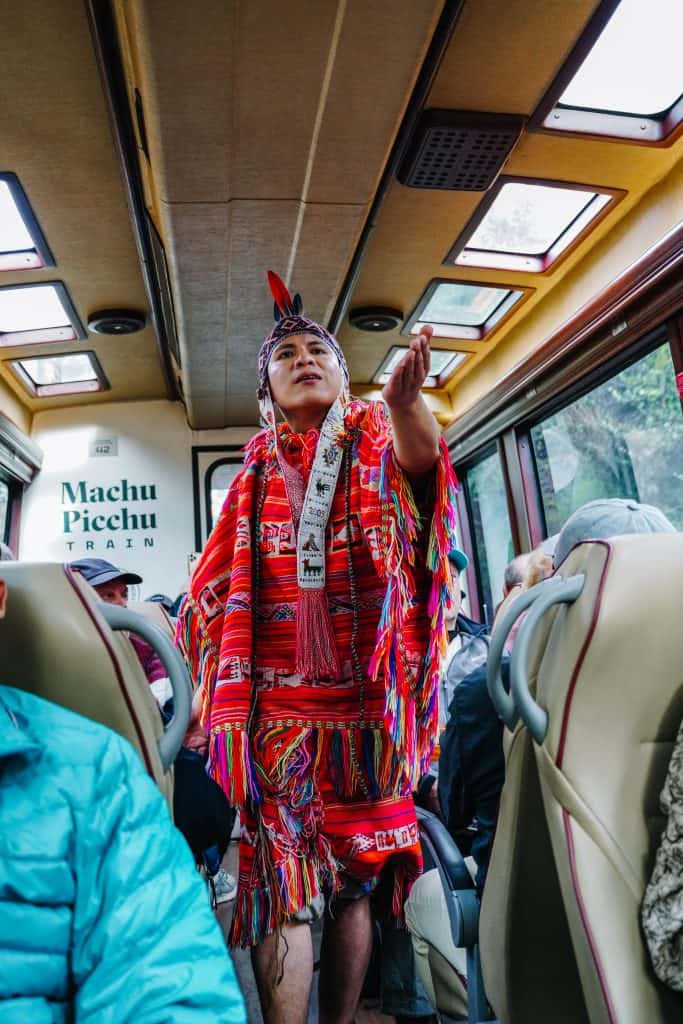
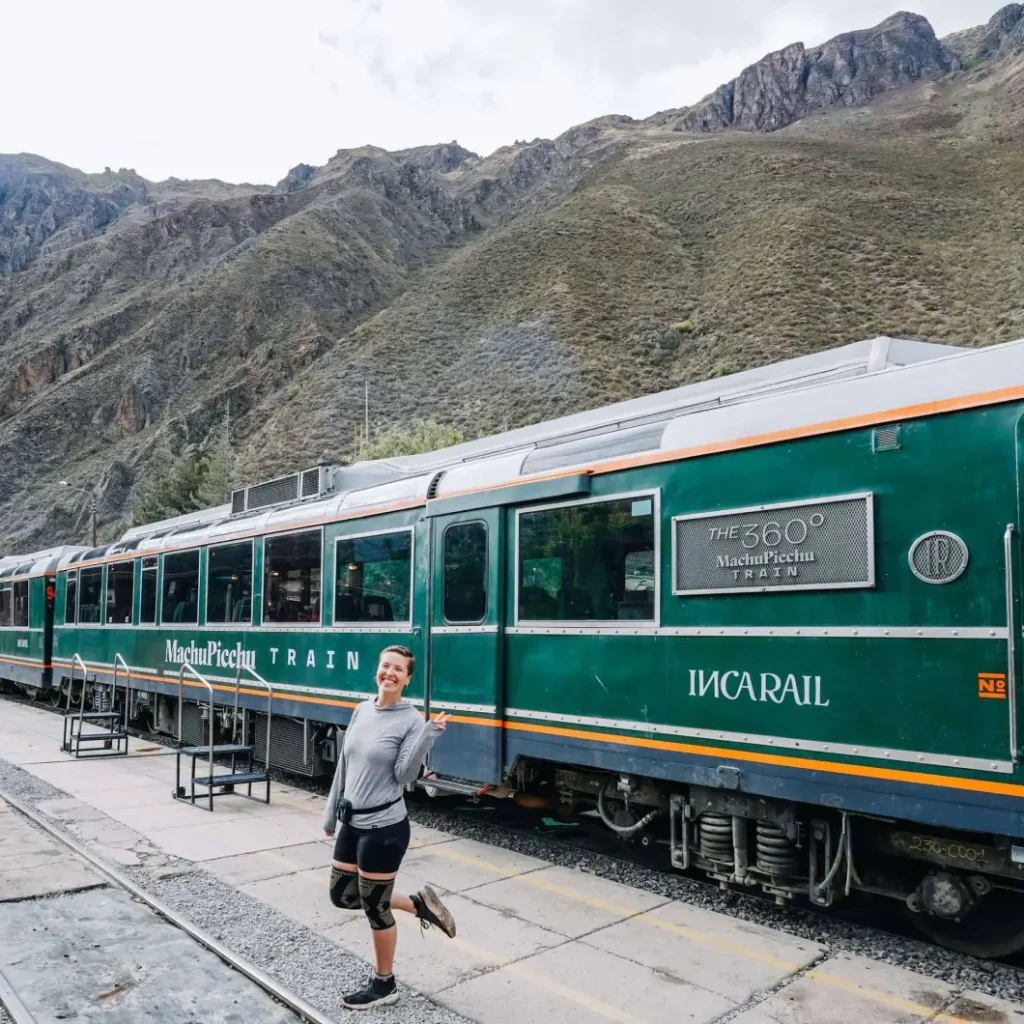
SUBSCRIBE AND JOIN THE COMMUNITY ♡
You’ll also be the first to hear about everything new and juicy, stuff you’ll probably want to know about: Website updates, new products, new articles, inspiration, promotions, and even giveaways!! (You don’t want to miss out on those!) Giveaways can be products, trips, subscriptions and so much more!Welcome! ♡
You have successfully joined our subscriber list, be on the lookout for your welcome email! ♡
Machu Picchu By Foot
Who said who can’t go to Machu Picchu by foot? Well, good news! Trekking holidays to the mysterious city are ideal, especially if you want to immerse yourself fully into the stunning natural landscape of terraced fields, sapphire rivers, and surrounding mountains.
Some tour operators in Peru provide comprehensive routes and distances for you to find a trip according to your preferences such as the number of days you have for city exploration, your choice of accommodation, and fitness level. Cover the Inca Trail with group and individual treks that ranges from 1 to 12 days. Plus, you can also go to the Mountain Lodges, at a pace that fits you, allowing you to gradually get used to the altitude.
Some specific terms and conditions restrict the number of walkers allowed on the Inca Trail, to allow for better environmental protections, as well as to ensure everyone has a peaceful experience. To start the Inca Trail trek to Machu Picchu, only 500 people are allowed each day, including the porters. It’s important to organize your trip as soon as possible if you want to experience getting to Machu Picchu by foot because permits sell out quickly.
🌿 Wellness Tip: Of course, feet are essential and play an essential role in your voyage. It’s best to come prepared and wear shoes that will protect your feet from possible dangers such as bruises, sores, or wounds. I absolutely love these toe socks to prevent blisters and friction between the toes, these shoes for grip, and these trekking poles for
Best Times To Visit
Oftentimes, official rainy season is October through April, but, it can rain anytime, although a shorter time in the dryer months. So, make sure you bring your rain essentials when traveling, I’ll share a list towards the end. During the rainy season, mornings are most likely to be foggy, making it a less desired time for traveling, since fog ruins the view.
Peak season is between July to August, and large crowds are usually during this time. Also, Sundays can be the most crowded, because this is the day when people from Cusco province can enter the site for free.
However, afternoons in Machu Picchu tend to be slightly less crowded compared to other times as day-trippers return to their respective train stations for their trip back to Cusco. Plus, If you’re one of the people who travel to Machu Picchu by riding on a rail, then the best time to visit is between late March and May, or September and November. These months are the summer solstice and aren’t so hot or crowded. Rain showers can happen, but are less likely to affect your trip that much, compared to heavy rains.
It’s also essential to note that trails are combined with certain circumstances such as mudslides during rainier seasons, so if you’re thinking about hiking the Incan Trail, it’s best to stay on top of the weather forecasts and plan accordingly.
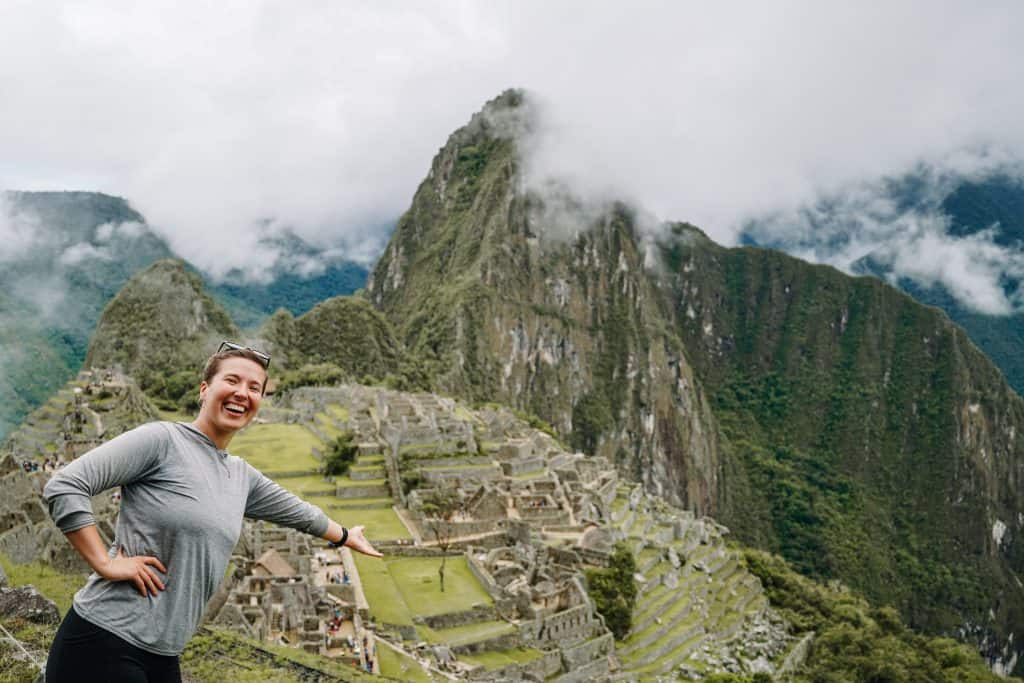
Top Things To Do At Macchu Picchu
No journey to Peru would be satisfying without a visit to the ‘lost city’ of Machu Picchu, a place that holds many secrets about the ancient Incan Empire. If you’re a huge fan of historical pieces, this place is absolutely perfect for you!
Every month, knowledge-seekers find plenty of interesting facts to mull over about the city’s mystery and archaeological site. Also, when you visit Machu Picchu, you’ll have the chance to learn about the various scientific and religious methodologies of the Incans who built the amazing site. Isn’t that exciting?!? I’m someone who can definitely nerd out about this stuff too!
Throughout your adventure to the small town of Machu Picchu, if you and your beloved ones stay a while, you can make trips to many of the city’s historical wonders. Such as discovering the beauty of Nazca Valley, several mountains shaped like beautiful rainbow stripes, and more!Machu Picchu is stretched over 13 km², which means that there are hundreds of breathtaking attractions that will surely make your trip more memorable and enjoyable! Here’s how to expertly navigate your trip to Peru’s main attractions. Plus I’ve included packing, sustainability, and wellness tips to ensure you enjoy your itinerary to Machu Picchu.
Hike Huayna Picchu OR Huchu’Y Picchu For A New View
In every classic photo of Machu Picchu, you probably notice that there’s always mountains rising in the background. Well, that’s the Huayna Picchu and Huchy’Y Picchu, the mountains overlooking Machu Picchu and the ruins, one of the most popular attractions on Machu Picchu itself. Thousands of tourists arrive here every year, hike Huayna Picchu and Huchy’Y Picchu, and then explore the scenic views of the surrounding mountains and sacred valley.
When it comes to Huayna Picchu, It usually takes about two to three hours to finish the hike and is about 4 kilometers (2.5 mi) round trip. Once you reach the top, you’ll see the entire Machu Picchu with its incomparable beauty and the stunning greenish tapestry that surrounds it. If you’re one of the people who enjoy all-terrain hikes and want to experience more physically rewarding activities, just do it!
It is important to note that if you do decide to venture on up, access opens as soon as 7:00 am and closes between 3-5:00pm depending upon when dusk is, at that time of year.
Also, be sure to note that the steps can get steep in places and can be slippery when wet. Make sure to bring the right gear when hiking Huayna Picchu Mountain. However, if you’re looking for something that’s a bit less physically demanding, I’d recommend hiking Huchu’Y Picchu. It’s only about 40ish minutes round trip, 70 meters (220 ft), and rated a bit more on the east side. It’s also a great spot to enjoy some snacking or a packed lunch too!
TIP: Just an insider tip. I recommend securing your entrance ticket early because the management only permits 400 visitors daily. Coming early in the morning would be the best idea, as it allows you to enjoy cooler temperatures, stunning morning light, and quieter paths.
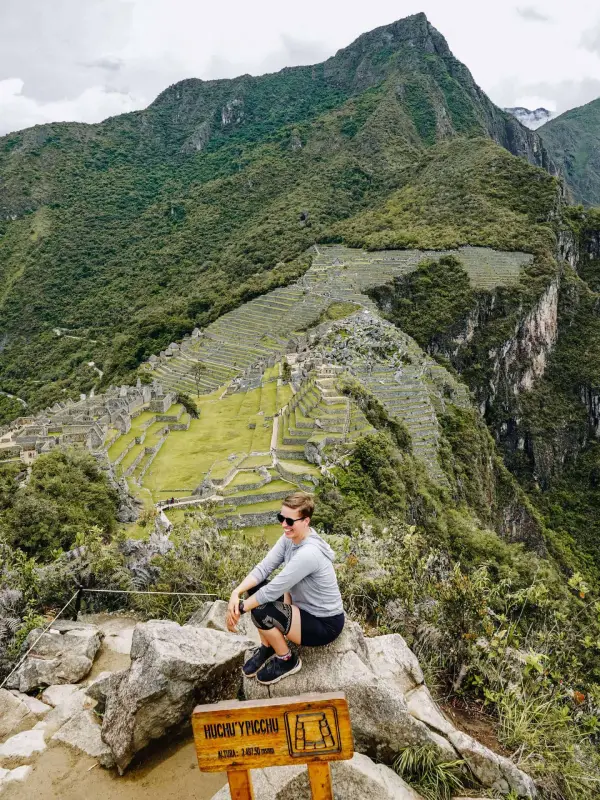
Take The Best Photo In The Guardian’s House
Did you know that the classic postcard of the Inca Citadel was done by following the marked path from the entrance of the Guardian’s House? One of the most satisfying things when traveling is having memorable photos, to reflect on or even show our family. Although photos aren’t everything, they allow us to keep the memories alive a bit longer.
The Guardian House is located in the upper part of Machu Picchu at about 2,430 meters (7972.44 ft) just above sea level. To get there, you need to enter the archaeological site and follow lap 1 or 2 towards the stone steps. The Ascent walk takes approximately 15 minutes before arriving at the Casa del Guardian. I recommend that you get there during the dry season to avoid fogs and disturbances in your portraits, or go in the afternoon, when the fog surpasses.
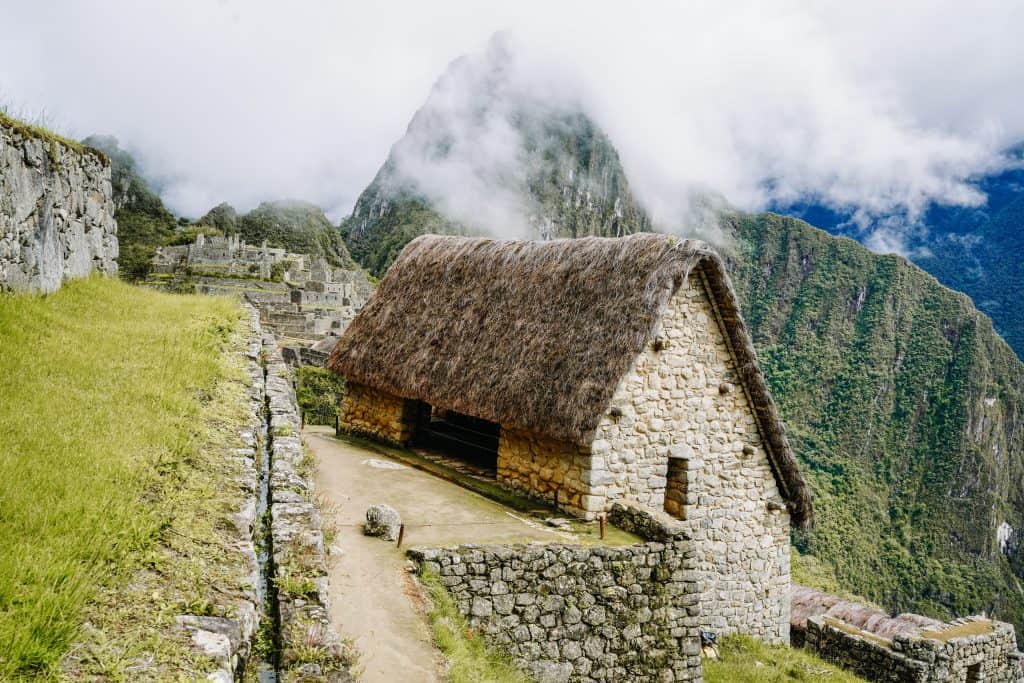
Hangout With The Llamas & Alpacas
To have an interaction with one of Peru’s indigenous llamas or alpacas is a ‘one for the books’ moments-especially because the photos with them are just so darn adorable! Oftentimes, you’ll see llamas and alpacas walking throughout the ruins, sometimes even with their babies.
These massive wooly animals are currently the only inhabitants of Machu Picchu, and are prized throughout Peru. After millennia of existence, llamas and Alpacas are known as both a tourist attraction and an essential part of Peruvian history.
On a fun note; they have a great deal of curiosity and are quickly trained. Vacation photographers visiting Machu Picchu will have an abundance of “photobombs” with llamas on their rolls.
Alpacas and llamas are also quite docile; but I don’t recommend touching them or even getting too close. Especially because if they want to ward you off, they’ll spit. But their spit isn’t just made up of saliva, it’s also made up of stomach acids, giving it a horrible smell. This doesn’t alter the fact, though, that meeting these amazing animals will undoubtedly add a unique and fluffy touch to your Machu Picchu journey!
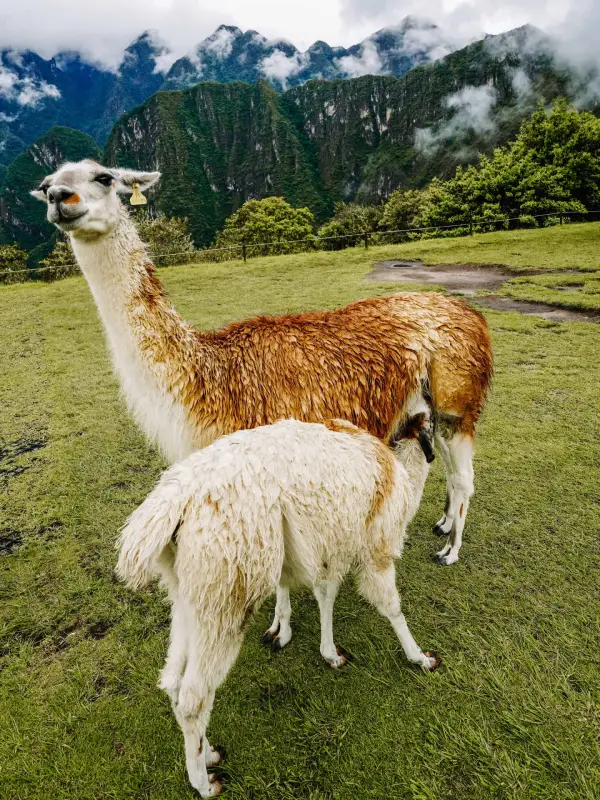
Walk The Inca Bridge
As the city’s testament to the strategic ingenuity and masterful creations of the ancient Inca empire, Inca Bridge serves as a secret entrance to the citadel. It was built primarily for the Inca army and carved into a cliff on the western route, separated by a hole in the middle of the road. Measuring a 20-foot drop, it’s hole was used to scare away unwanted visitors.
The Inca Bridge’s path features the ability of ancient Incas to ingeniously make defense mechanisms by natural landscape. Also, its sleek yet brilliant design included wooden planks, which could be removed anytime they wanted, making it easier for them to escape and hide. Today, the original wooden planks are gone, but the path remains secure. It’s still safe to walk through the Inca Bridge since there’s a strong foundation to the tactical acumen of Inca’s civilization. However, walking to the bridge requires enough confidence and a steady nerve to perfectly navigate the narrow trails with its sheer drop-offs. Looking for an adrenaline fill?
For ticketing, you don’t need to have an entrance pass, hike freely to the Inca Bridge with your regular Machu Picchu ticket. As long as you go there before your guided tour at Machu Picchu citadel. To enter the main Machu Picchu site, you can arrive as early as 6am and claim a 7am–8am time window for the bridge. This enables you to take in the tranquilizing effects of the light while viewing the entire morning. If you love challenges and test the limits, then this is for you!
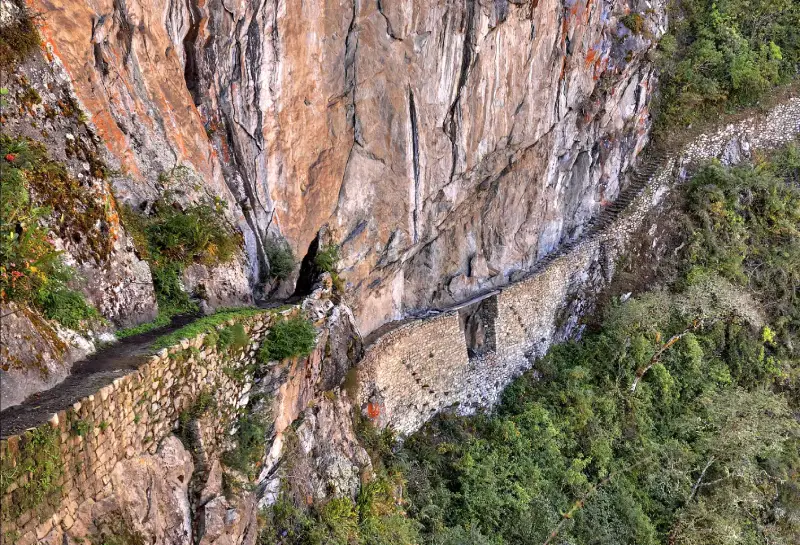
Learn About The Manuel Chavez Ballon Museum
Since Machu Picchu is the home of mysteries and history in Peru, museums showcase prized pieces for all to enjoy! Bring your family and friends to the Manuel Chavez Ballon Museum, a dedicated little-visited gem to the rediscovery and culture of Machu Picchu, and let them experience a historic visit. Exhibit pieces were found in the museum as well as instructional panels that were used during the staging process of the Incas. Manuel Chavez Ballon Museum has up to 7 showrooms and 8 sequences, including picturesque learning panels and materials.
Did you know that the original edition of the 1913 National Geographic magazine that published and introduced Machu Picchu to the world can be seen in this museum? Interesting, isn’t it? Once you come here, you’ll be amazed by more surprises, especially learning about the traditional practices and daily lives of the locals.
Generally, tickets can be purchased at the entrance and adult tickets are about 22 soles or $6 USD, and students are about 11 soles or $3.50 USD.
Address: Sendero al Museo, 08680
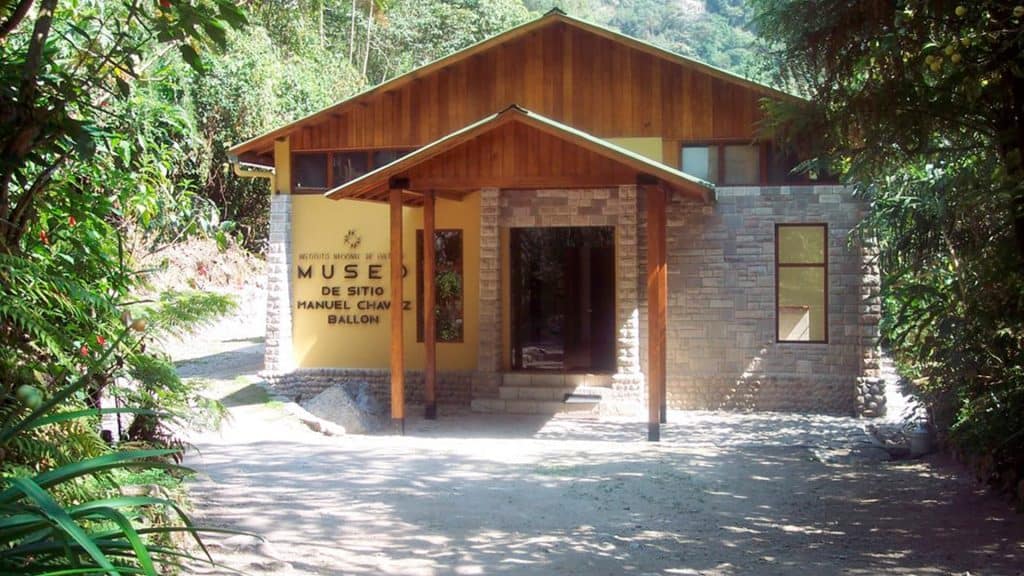
Find the Intihuatana Stone
Missing the Intihuatana Stone when you come to Machu Picchu will be a disaster! One thing that stands out and perhaps implies the mysterious claims of the city is the intriguing sacred stones. It’s one of the most visited attractions in Machu Picchu and stands at the highest elevation in the archaeological site. Situated above a pyramid-like tiered form with the rock on top, Intihuatana Stone holds several magical facts about the city.
It’s a mesmerizing four-sided stone with each point representing the north, south, east, and west, and features a granite block similar to a bench or altar. Other steps and dents are noticeable, which people believed to be the indication of rituals made on the Intihuatana. Inca priests also use the sacred Intihuatana Stone for astronomical reasons, especially when observing the sun. Many of us know that the stone was aligned with the sun’s position because it has been shown to be the exact indicator of the date of the two equinoxes.
Oftentimes, you’ll see people either pray, give an offering, or place their hands at the base of the sacred rock, because locals claim that it’s the location where priests use sacred cords to perform significant spiritual sessions. If you’re here for the energy, don’t miss this spot!
Wander the Botanical Garden
Finished witnessing the interesting facts about Machu Picchu at the museum? Next, it’s time to witness the beauty of the botanical garden located next to the museum! Just a few steps from the museum; you’ll discover a place where diverse species of plants, flowers, and trees reside. An area totaling 37,302 hectares is under the protection of the Peruvian State as the Historic Sanctuary of Machu Picchu. Up to fourteen distinct living zones, including cloud, rainfall, and queuña woods, have been designated within this area. A wide variety of plants, foliage, and blooms were found there. You may enjoy some of this richness of flora when you visit Inca city.
Nonetheless, it’s a great choice is to go to Machu Picchu’s botanical garden. From palm trees, orchid species, lemon trees, to viewing the beautiful national bird of Peru, everything at the botanical garden is absolutely beautiful. One aspect that I had found absolutely amazing in Peru, was the amount of variety in climates, it’s as if almost everything can grow there. From apples, to lemon, or even exotic fruits like sapotes.Normally, all serperated by different climates. it’s astonishing.
Foreign visitors must pay 22 soles (5.84 USD) to enter the site museum and botanical garden, while domestic visitors must pay 11 soles (2.92 USD). Monday through Sunday starting at 9:00 a.m., you can enter till 5:00 p.m. and children get free entrance.
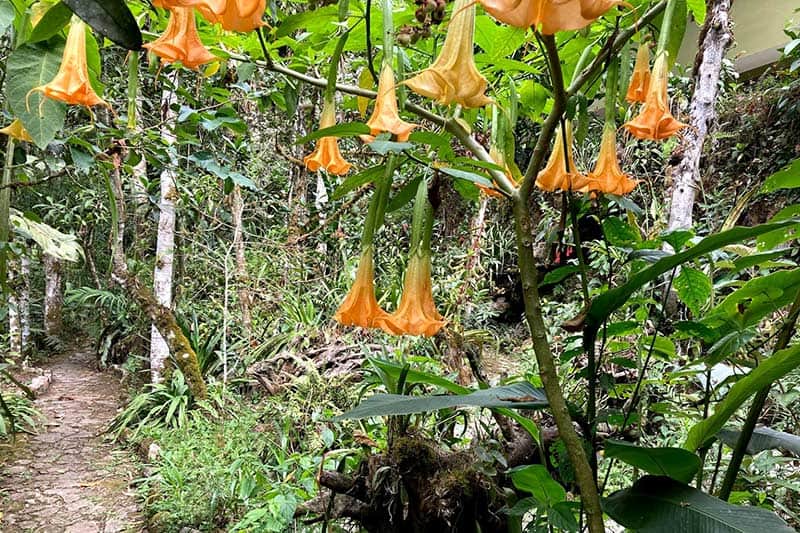
Enjoy The Stunning Terraces
One of the most essential cultures in Machu Picchu is the Inca culture, which left a physical legacy of the pre-Columbian civilizations in the territory of Peru. Truly, the terraces of Machu Picchu are living proof of the Incas’ intelligence, advanced agricultural techniques, creativity, and environmental ingenuity, especially when creating steep and complex access areas such as the Andean Mountains.
Carved into the surrounding mountains, the beautiful agricultural terraces allowed for a wide range of crops, with each terrace making its own microclimate as well as having it’s own irrigation channels.
Machu Picchu’s terraces also increased the amount of land Incans were able to use to cultivate and grow crops. Which is absolutely astonishing, since they lived within the mountain sides! Incans were able to evolve and adapt their practices in the field of agriculture to the encircling landscape without the need to worry about mudslides.
If you want to see a mixture of beauty and inventiveness etched into the landscape, explore the terraces and you’ll never be disappointed.
♻️ Sustainability tip: Make sure to wear sunscreen for a full protection as you view the terraces. There are a lot of exposed areas, and you might experience a sunburn when unprotected. Check out my favorite sunscreen here! It’s non-toxic and contains natural ingredients which are good for your face and body.
Indulge Yourself At The Mandor Falls
Undoubtedly, there are multiple paradises you can find in Machu Picchu, but one of the sites that truly stand out for me is the Mandor Falls. It’s one of the city’s must-see attractions, a beautiful natural resource that’s located in the district of Machu Picchu.
Mandor Falls pours down a rocky cliff, dropping almost 330 feet (100.58 meters) into a pool below and has a slope of thirty meters. Mandor Falls has a heavier water flow during the rainy season, giving the breathtaking views seen in the photos, compared to its regular sight. During the rainier season, the mist from the falls creates an amazing experience for those that want to cool off a bit Also, leading paths to Mandor Falls have spots without light, and it’s going to be a bit cold, so it’s best to pack some warm clothes too
Keep in mind that when visiting the waterfalls, you have to be extra careful of some endangered animals such as spectacled bears, and give honor to their respective habitat. As long as you don’t disturb and threaten their peace, they’re generally not a dangerous animal.
To enter the waterfall, you need to take a walk for about forty minutes. The entrance to the waterfall will be visible by signs, and can be paid onsite for about ten soles.
Address: Mandor Valley – Machupicchu Km. 114. 3, Aguas Calientes, Machu Picchu Peru
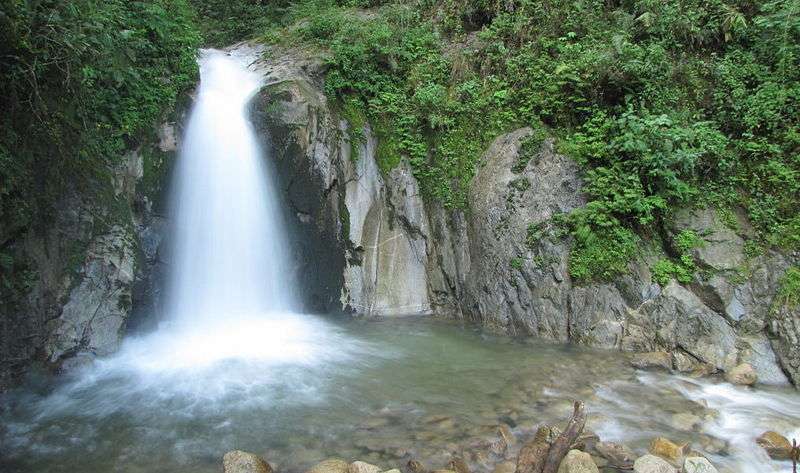
Feel The Energy At The Temple of the Moon
Are you one of those people who love to visit a temple? If so, then this activity is a good idea! Machu Picchu offers a principal temple with beautiful niches and doors in the stones under the overhanging cave. The Temple of the Moon is made up of a huge entrance and a rock carved in an altar form. Which is located 5 km away from the city, and in the open face of a shallow and natural cave near the archaeological complex of Qenqo. Usually, open between 6 a.m. to 5 p.m.
There’s actually a temple of three windows of Inca religion: the Kay Pacha (the earth), the Ukju Pacha (the underworld), and the Hanan Pacha (the heavens), presented separately by the puma, the snake, and the condor. Inside the main temple, one way of paying respects and honoring the gods is making offerings to the Moon or the Pachamama with coca plants, sweets, and wheat! It’s said that once you offer something to the Moon, it’s said that you’ll receive great news when you get home. If the ancestors cherish it, there’s nothing wrong with trying, right?
Address: RFX3+5CW, Aguas Calientes 08680, Peru
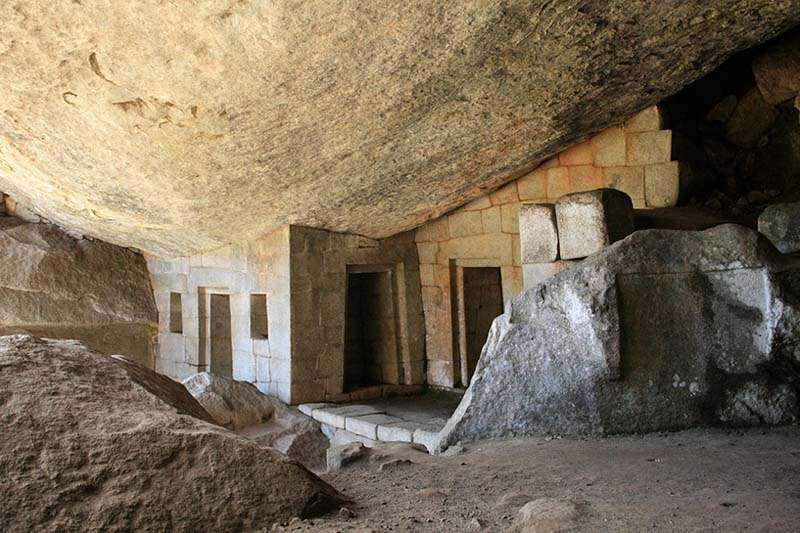
Watch The Beautiful Butterflies At Mariposario de Machupicchu
Who doesn’t love butterflies? I believe they all hold a special place in our hearts. They’re one of the cutest creations in this world, and seeing them up close is certainly a must! Aside from the historical mystery that Machu Picchu offers, it also provides a beautiful sanctuary of butterflies that sits at its foot near the river.
When you get inside Mariposario, hundreds of butterflies from across Peru’s region are waiting for you to see them! See exotic species like the morpho butterfly, the largest butterfly in the world, with wings spanning from five to eight inches! Of course, you’re allowed to take pictures inside, so make sure your phone has enough storage. The entrance fee costs $3 (11.30 soles) per person. Enjoy watching butterflies sip nectar from the flower gardens such as lavender, salvia, tulips, rose topiaries, orchids, and hydrangeas!
As you walk through the site, they’ll also share the importance of butterflies in Inca mythology and culture and learn more about their incredible biodiversity. Visiting the Mariposario in Machu Picchu is a peaceful and educational experience for nature lovers of all ages.
Address: Avenida Hermanos Ayar, 08680, Peru
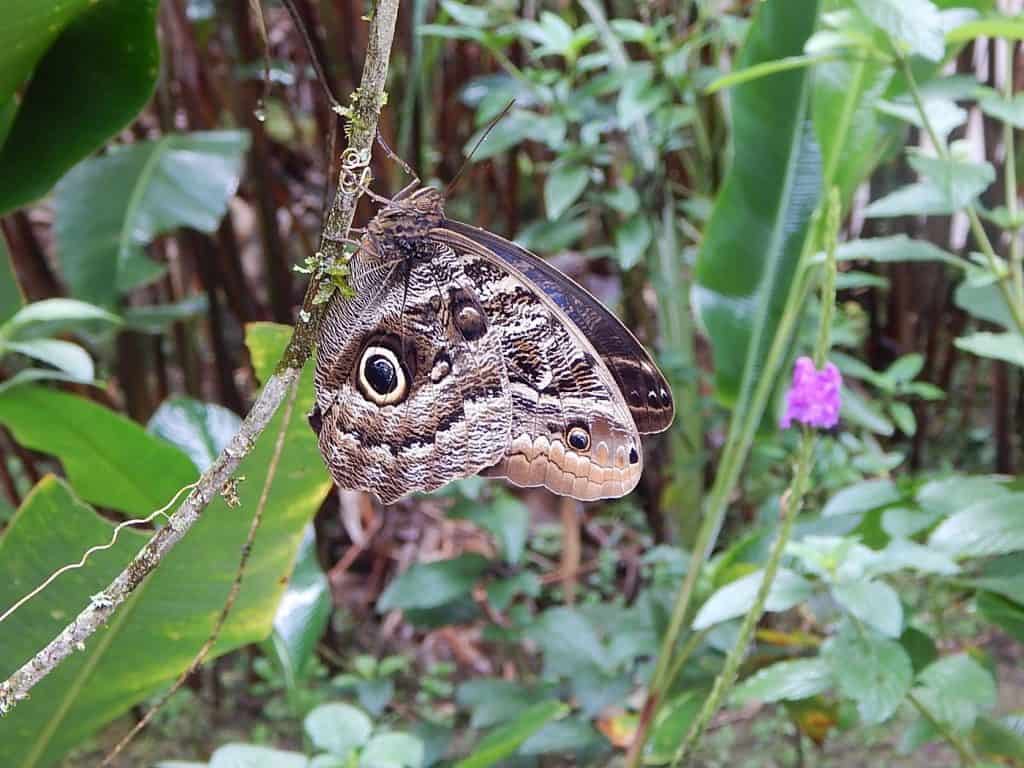
Explore The Intriguing Royal Tomb
It’s never too late for you to uncover the mystery of Machu Picchu’s Royal Tomb, nestled beneath the Temple of the Sun. Its graceful masonry and solemn designs are primarily made and reserved for virtue and other significant rituals.
The Royal Tomb’s interior has a well-finished and excellent sculpture with a perfect symmetry, chamber walls, doors, and four large sizes of niches. The top of its walls allow you to enjoy a view of different stones in cylindrical forms. Also, the Royal Tomb features an arrangement of large protrusion of rocks that will surely allow you to feel the sacred energy that this tomb has been blessed with!
Although, the real purpose of the Royal Tomb remains a mystery, as no absolute burial proof has been found. Many archaeologists suggest that it may have been used as a site or the main temple for ritual sessions, high-status ceremonies, and astronomical observations, supported by its magnificent stonework. It’s truly worth feeling.
Address: Cam. Inca, 08680, Peru

Packing For Your Machu Picchu Trip
Machu Picchu is a land of extremes and holds a wide range of fun activities as well as weather conditions. In fact, ain can happen anytime as well as extreme levels of heat, which is why layers of different clothes makes it easier to adapt.
During the dry season, the weather can actually be rather cold and windy. With a height of around 16,400 feet (5,000 meters) above sea level, the higher you climb, the colder it will get.
Plus, your layers also depend on what activities you choose to do and how you got there. Not to worry, whatever your travel plans, we listed the things you should include in your bags like a pro.
Things To Bring

- Sunglasses, sunscreen, and a hat
- Rain jacket + gear
- Comfortable leggings (for women)
- Vest
- UV protection shirt
- Trekking poles for extra stability
- Thick and warm layers
- Portable charger
- Water bottle
- Small travel packs
TIP: Please know that when you are getting on the bus, when you are going into Machu Picchu, and when you are boarding the train, they will check your passport and your tickets constantly. So make sure to have those by your side as often as possible.
Things To Leave Behind
- ♻️ Plastic water bottles and plastic bags – The government recently implemented a regulation where use of plastics on the Inca Trail and other protected sites in Machu Picchu are prohibited.
- Travel bags or backpacks bigger than 40 x 40 cm. There will be a checkpoint where you’re allowed to leave some heavy packs after hiking the Inca Trail to get to Machu Picchu. But if you’re not want to leave anything with them, then it may not be best to bring it.
- Tripods and other professional cameras – Permits for professional cameras can cost more than $300 (1,130.26 soles) if they choose to enforce it. I kept mine in a cross-body bag, and nobody seemed to notice it much.
- Big umbrellas with spikes
Planing Your Machu Picchu Trip Now
Now you can see part of the reasons why the things to do at Machu Picchu and everything on this sacred mountain make it one of the true wonders of the world. The energy is strong, the people are sweet, the mountains are mighty, and it’s astounding. I hope you will bring yourself or your family here to enjoy a voyage that is well worth the effort, time, and money.
Just don’t forget that you must make reservations in advance and buy tickets as soon as possible if you want to be fully immersed in an enjoyable and thrilling vacation.
Also, be sure to explore some tours, guides, and anything else that you may want to add on. Lastly, I will note, I’d had my experience booked for me, so I had very little to worry about, I was guided and had a wonderful space to come back to at and through Pacha Munay Wellness.
Looking To Explore More Of Peru? Check Out These Other Spots:
You May Also Like...
Serenity
Hey there, It's so great to have you here, As a sustainable travel blogger, I try to create original, captivating, and quality content to support and inspire you! So, if you feel called to comment any praise or ideas, I encourage you to. Your input is valuable to me! Pssstttt...Don’t forget to subscribe to the newsletter to get those goodies that are only available to those on the list. I don't want you to miss out on anything! Have a blissfully serene day, and thank you for being here, and I hope to see more of you!♡


Lou Brown
Wonderful web site Lots of useful info here Im sending it to a few friends ans additionally sharing in delicious And obviously thanks to your effort
Teppichreinigung Reinigungsmaschinen München
Toller Artikel! Ich fand die Informationen wirklich hilfreich und aufschlussreich. Es ist immer erfrischend, auf so gut recherchierte Inhalte wie diesen zu stoßen. Mach weiter so! Ich freue mich darauf, in Zukunft mehr von dir zu lesen.” English. Great article! I found the information really helpful and insightful. It’s always refreshing to come across well-researched content like this. Keep up the fantastic work! Looking forward to reading more from you in the future.”
Kitty
What a remarkable article! The way you’ve tackled the topic with such precision and depth is commendable. Readers are sure to gain a great deal from the wealth of knowledge and practical insights you’ve shared. Your profound understanding of the subject shines through every part of the piece. I’m eager to see more of your exceptional work. Thank you for offering your expertise and providing us with such enlightening and comprehensive content.
Macie Nicolas
Your passion for writing is evident.
Claudine Cartwright
Keep up the fantastic work!
Morris
I simply could not go away your web site prior to suggesting that I really enjoyed the standard info a person supply on your guests Is going to be back incessantly to investigate crosscheck new posts
Pearl Rem
Fantastic site Lots of helpful information here I am sending it to some friends ans additionally sharing in delicious And of course thanks for your effort
Edison
My brother suggested I might like this website He was totally right This post actually made my day You cannt imagine just how much time I had spent for this information Thanks
Matteo Iure
Its like you read my mind You appear to know so much about this like you wrote the book in it or something I think that you can do with a few pics to drive the message home a little bit but other than that this is fantastic blog A great read Ill certainly be back
Kellie
Excellent blog here Also your website loads up very fast What web host are you using Can I get your affiliate link to your host I wish my web site loaded up as quickly as yours lol
Alfreda Tempora
Obrigado pelo bom artigo Na verdade, foi uma conta de diversão, parece muito mais agradável de sua parte. No entanto, como poderíamos nos comunicar
Elisabeth Suscipit
Excellent piece! You really impressed me with your thorough research and insightful commentary on the subject. The way you write is captivating and the plot flows well. Your use of concrete examples greatly aided my comprehension of the ideas. I appreciate you taking the time to provide this helpful data.
Korbin Veniam
Normalmente eu não leio artigos em blogs, mas gostaria de dizer que este artigo me obrigou muito a dar uma olhada e fazê-lo. Seu estilo de escrita me surpreendeu. Obrigado, artigo muito bom
Arvel Numquam
Somebody essentially lend a hand to make significantly articles Id state That is the very first time I frequented your website page and up to now I surprised with the research you made to make this actual submit amazing Wonderful task